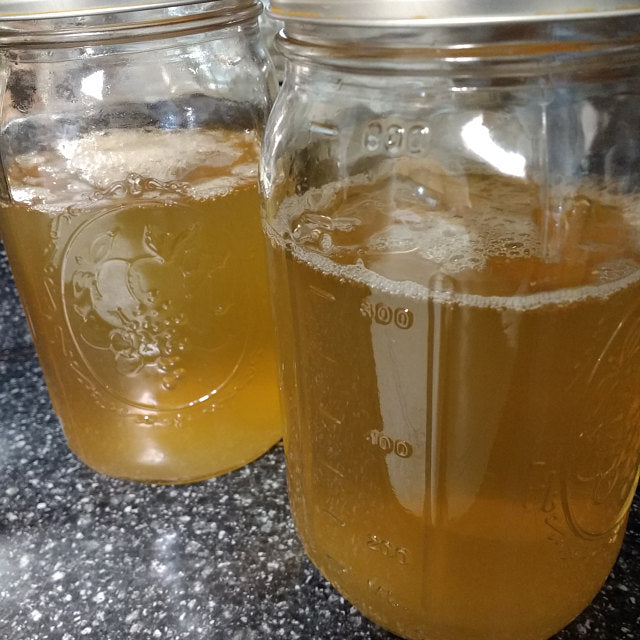
When it comes to water kefir or ginger beer, most people prefer it fizzy. It adds dimension, taste and fun to a healthy beverage. For those who just have to have that fizz, here’s our guide to getting the most fizz out of your fermented beverage:
Everyone talks about 2nd ferments when it comes to carbonation, but the real key to getting good carbonation is a strong first ferment. If your first ferment is weak, you will likely have trouble getting significant fizz no matter what you do during the 2nd ferment. If its still really sweet after 48 hours, you will have a hard time getting that delicious multidimensional flavor or much carbonation during the 2nd ferment or storage. Carbonation tends to kick into gear only when the yeast is strong and the sugar content is low.
- Minerals in the sugar, Minerals in the water.
Yeast is what creates the carbonation. The stronger the yeast, the stronger the fizz. Yeast loves minerals, so make sure to do a mineral rich ferment with at-least 50% of a dark mineral sugar. Try a spoonful of molasses to really get that yeast happy. Also, minerals in the water is just as important. Mineral or well water is best. If you have to use filtered water or your water is really soft, then add some trace mineral drops or calcium supplements. Boiled egg shells, baking soda, dolomite are good choices.
- Heat

Yeast loves the heat and helps create stronger yeast. Try for the low to mid 70’s for a strong balanced ferment. If its below 70, it can still ferment fine, but it tends to be bacteria rich and sour instead of tangy and fizzy.
1. 2nd Ferment
Now that you have a strong first ferment that’s not very sweet anymore and somewhat tangy, its ready for a 2nd ferment. It may be already slightly fizzy or have very little fizz, either way is okay.
Here are some things you can add during the 2nd ferment (when the grains are out) to really get that carbonation going during:
-
Fruit Juice: Fruit juices are probably the easiest way to get carbonation. Be aware that fruit juices can also create higher levels of alcohol. I recommend grape juice, its delicious and can create a bombs worth amount of carbonation. Apple, pomegranate, cherry, prune juice are also good options. Add a couple ounces and let sit for 1-2 days at room temperature with a lid on. Keep an eye on it though as the carbonation does have the potential to break the jar. Burp the jar or bottle if need be. Chill in the fridge before drinking.
-
Fresh ginger: The yeast will thank you. You can use the juice but blending the ginger with some water and then strain the juice from all the fiber. Another option is to peel the ginger and cut up discs of ginger which you can easily remove before consuming.
-
Organic Lemon, lime or orange peel: Citrus peels can make it fizzy and delicious. Be sure to take them out after a few hours so it doesn’t become bitter though.
- Add a teaspoon or so of fresh sugar: Any sugar can work, but darker sugars tend to work a little better.
3. Swing top bottles
Swing top bottles are a must for those serious about bottling and carbonation. It’s ideal for building carbonation and durable enough to withstand extreme carbonation (although be aware that they can still break). I recommend leaving about a 2 inch head space when bottling the kefir.
5. Airlock or closed lid first ferment
Water kefir can ferment anaerobic (without oxygen) if desired. Traditionally, water kefir was fermented with an open lid, but they can do just as well with a closed lid or airlock system. If you want carbonation / fizz and want to drink it fresh without a 2nd ferment, then this is the best option. If you plan to do a 2nd ferment or a few days of storage in the fridge, then it doesn't really matter that much if you use a open or closed lid.
4. Ginger beer plant
Try the ginger beer plant instead of water kefir grains. Ginger beer tends to be naturally fizzier than water kefir due to the yeast composition, higher mineral needs and longer ferments.
5. Fridge storage
Skip the 2nd ferment and simply store in the fridge. Some of my strongest fizzy ferments are ferments that are simply stored in a closed lid in the fridge for a few days without a 2nd ferment. If you had a strong ferment with plenty of yeast activity, a few days in the fridge will build a significant amount of carbonation without the need to add anything else.
Note: You can combine 2nd ferments and a long fridge storage for even more carbonation.
6. Water Kefir Recipes
Search our favorite water kefir recipes that are balanced for flavor as well as fizz. Most will create an abundant amount of carbonation to satisfy your all fizzy needs.
Summary: Start with a strong first ferment which includes a mineral / nutrient rich recipe as well as mineral rich water. Ferment for 48 hours in the 70-75 degree range. Do a 2nd ferment with a bit of fruit juice or ginger or citric peels or fresh sugar (or a combination). Let sit for 1-2 days. Chill in the fridge and enjoy.





Comments
Terry
Update…I’m still trying to get that first ferment. I’ve tried the crushed eggshells, baking soda and dried fruit/crystallized ginger, and while I’m seeing lots of bubbles now it still tastes like it’s not digesting the sugar. I haven’t tried dolomite but I have some food-grade diatomaceous earth and wonder if this would help(?). Our tap water is pretty soft and I filter it mainly for chlorine and the dechlorination by-products which are apparently high, so using unfiltered water likely would not help. My “old” batches have become a little foamy with the addition of fresh ginger, but I’m guessing this is from a different kind of fermentation as the flavor is altered but they’re still not very fizzy. Overall I’m scratching my head trying to figure out what I’m looking at.
July 12, 2020
Terry
I split my grains into two batches to make fruit juice kefir and plain water kefir. The fruit juice kefir takes off like crazy such that I’ve divided it again into two batches, as it ferments so quickly that we can’t drink it fast enough (I change the juice every 24hrs). The water kefir has not been responding nearly as well, so I have to assume that my tap water is the problem. I already filter it for chlorine and I ordered some bone charcoal to remove the fluoride which has helped I think. My question is whether my already-“fermented” water kefir can be put back with the grains a second time(?), as from what I’ve read here it never fermented properly to begin with. I used sucanat (granulated molasses) and left each batch for 48hrs+ but after putting it in a plastic jug with a screw-top any gas buildup disperses quickly when I remove the lid for tasting and it’s nowhere near being fizzy, while also still tasting like sucanat-water. By contrast I have to burp the juice kefir several times per day because its jug is so distended. I did order some Grolsch bottles and have started storing the juice kefir this way, but the water kefir isn’t ready for this. I will try adding some crushed eggshells to my current batch to see if this helps, and if so I’d like to re-try the previous batches.
June 11, 2020
Yemoos Nourishing Cultures
Hi Jane – Natural carbonation from the yeast is the best, but you can use carbonated / sparkling water to ferment water kefir if desired. In the short term, it doesn’t seem to hurt the grains, but I’m not sure how it impacts the ferment or grains long term.
April 13, 2020
Jane
Hi there
Could you tell me whether it is ok to use sparkling/carbonated water to ferment the kefir grains – instead of still bottled water – many thanks Jane
April 13, 2020
Paul
1.Awesome tips on carbonation, I’d managed to get one really good batch but couldn’t repeat it. Now I know what I’ve been doing wrong :)
2.I think you wanted to use “citric” or, actually, “citrus” in summary ;)
PS Need a dirt cheap proofreader from Eastern Europe? :v
Cheers
February 05, 2020
Yemoos Nourishing Cultures
Hi Erik, the healthy normal range of bubbles in a water kefir ferment can vary quite a bit. The balance between the bacteria and yeast, temperature, recipe and amount of oxygen (anaerobic vs aerobic) can greatly change how many you see. If you see bubbles getting released when jolting the jar, then that’s a good sign and fairly typical, especially when its cold. If you sit and watch, you may see a bubble getting released every so often. There are times when you see constant free-flowing bubbles, but that’s more common in the summer months. Warmer, faster, yeastier ferments will generally create more bubbles. Keep in mind that a slow tangy bacteria rich ferment is still really good even though you may not see many bubbles. The carbonation is just one by-product of the yeast and not necessarily indicative of how strong the overall ferment is. Try to go by smell and taste to get the full picture.
December 17, 2019
Erik
Thanks for detailed post. I’ve fermented many different things now and am just getting into Water Kefir, have done 3-4 batches to date. I’m trying to determine whether my first/primary fermentation is completed and am doing so to taste, seems to be done after 2-3 days (my kitchen is quite cold). Can you comment on how vigorous the bubbling should be from the bed of kefir grains at the bottom of my jar? After a day or so, if I give my gar a light shake several bubbles will quickly come up through the jar, but I don’t see bubbles coming up regularly as it just sits there – like I am accustom to with many other types of fermentation that I’ve done. That leads me to wonder whether or not my primary fermentation has been strong or active enough.
December 17, 2019
Yemoos Nourishing Cultures
Hi Heidi – Yes, you can add lactobacillus strains from pills if desired. Water kefir grains have a strong natural balance and may be hostile to new strains so its hard to say if it will be picked up or not. But it will typically only be incorporated if its fits well within the balance, so I don’t think there’s any harm in trying.
November 27, 2019
Heidi
Hi Nathan- I want to experiment with adding different lactobacillus strains to my water kefir. Would this even work? If yes, would I just use, say, a pill crusher & then add a small amount to the first ferment & the grains would perhaps incorporate the new strain? What do you think?
November 27, 2019
Yemoos Nourishing Cultures
Hi Nathan – short of pasteurizing it, there’s not a whole lot you can do besides sticking it in the fridge and keeping it as cold as possible. You can freeze kefir though. Some of the probiotics will die, but much of it will survive.
November 02, 2019
Leave a comment